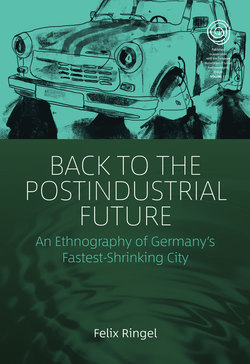Читать книгу Back to the Postindustrial Future - Felix Ringel - Страница 20
На сайте Литреса книга снята с продажи.
Notes
Оглавление1. The lyrics in German read rather beautifully: ‘Die Zukunft ist ´ne abgeschoss´ne Kugel, / auf der mein Name steht und die mich treffen muss. / Und meine Sache ist, wie ich sie fange, / mit’m Kopf, mit’m Arsch, mit der Hand oder mit der Wange. / Trifft sie mich wie ein Torpedo oder trifft sie wie ein Kuss?’ For the rest of the song, Gundermann uses further sets of metaphors, describing the future as an ‘unexplored country’ (ein unentdecktes Land), in which one has to choose sides with prey or predator; a ‘handed-in package’ (abgegebenes Päckchen), which could contain either a time bomb or precious issued stocks; and ‘a pale small woman’ (kleine blasse Frau), who is leaving and who one at this very moment could let go, force out or hold back. Despite their bleakness, these metaphors focus on the agency involved in how one might potentially define one’s relationship to the future.
2. Lusatia (Lausitz) is the name of the region surrounding Hoyerswerda. For centuries, it has been inhabited by the Slavic minority of the Sorbs (Sorben).
3. For another, although very different example of an ethnography looking at the future, see Lorenzo Cañás Bottos’ monograph on Old Colony Mennonites in Argentina and Bolovia (2008). He looks at the future relations of a community that for different and self-professed reasons was considered to be of the past. See also Holbraad and Pedersen 2013; Krøijer 2015.
4. I contrast this to theories that account for the influence of the past through a history of knowledge (practices). For example, Pels (2016) recently argued that we have to understand contemporary modes of representing and relating to the future in the West by accounting for the dominance of these modes over a time span of more than 500 years.
5. All names used in this monograph are real names. However, in reference to contentious issues, I altogether refrain from mentioning names and instead circumscribe the people involved via social status, age, gender, etc.
6. ‘Wenn eine Stadt kleiner wird, werden die Menschen in ihr dann größer?’
7. ‘Unser Ziel ist es in diesem Schrumpfungsprozess, den wir als solches akezeptiert haben, hier positiv einzugreifen, handlungsfähig zu bleiben, und darüber eine positive Stimmung zu erzeugen, die dann für eine andere, neue Lebensqualität und Lebenskultur sorgt.’
8. For critiques of East German Ostalgie, cf. Berdahl (1999, 2009) and Boyer (2001a, 2001b, 2006, 2010). Both authors show that temporal references to the GDR past should not be analysed as expressions of some form of past-fixation, but instead as critical contemporary statements with an inherent claim on the future.
9. He later strengthens this point by reference to the work of phenomenologists such as Husserl, who proposes that ‘our daily lives are lived within the set of temporal “horizons” which shift continually’ (Gell 1992: 221), ‘horizons of a temporally extended present’ (ibid.: 223), which still retain some continuity. Gell positions his own concept of temporal maps with regard to the key concepts of Husserl’s temporal phenomenology of perception, ‘retention’ and ‘protention’.
10. Guyer et al. draw attention to a particular disciplinary ‘prioritization of different temporal frames’ (2007: 7). In the field of anthropology, the future did indeed not play any prominent role for a long time (see Munn 1992).
11. For more detail on the newspaper columns, see the archive of the local newspaper, the Hoyerswerdaer Tageblatt. For visual material on the AnthroCamp08, the youth camp on anthropology, see www.kufa-hoyerswerda.de/anthro-camp-2008-2.html and https://www.youtube.com/watch?v=iwmuMOZVe18. For visual material on the community art project Malplatte, see http://www.kufa-hoyerswerda.de/2009-malplatte.html.
